PROTECT YOUR DNA WITH QUANTUM TECHNOLOGY
Orgo-Life the new way to the future Advertising by AdpathwayGarlic planting comes at a time when fall and winter weather make gardening nearly impossible. Gone are the bean teepees and corn stalks of summer, while frigid winds and bare tree branches are here to stay. Planting garlic at such a time is an act of hope, as you trust that the cloves will pop out of the soil next spring.
Plant ‘Nootka Rose’ garlic this fall and you’ll have exceptionally strong-flavored garlic bulbs to harvest next summer. The cloves don’t need cold weather to thrive, like hardneck types do, which makes this variety the perfect choice in warm climates, too. It tolerates arid or humid conditions.
‘Nootka Rose’ garlic is not only tough and reliable in the garden, it’s also versatile in the kitchen! Roast and mash it on toasted bread, or use sliced cloves to flavor soups, sautés, and sauces. Pickle the garlic in mason jars, or chop it into sauerkraut. The sky is the limit when it comes to growing and using this variety.
‘Nootka Rose’ Softneck Garlic
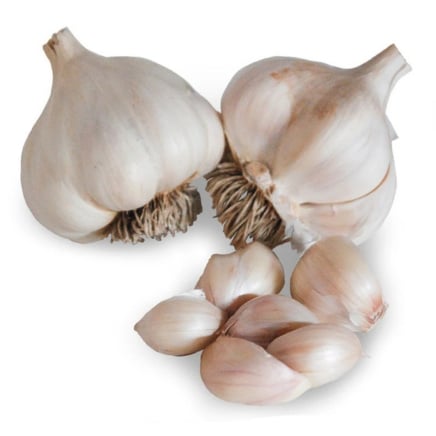
- Heirloom garlic, adapts to varied climates
- 12–20 red-streaked cloves per bulb
- Softneck, no cold needed
- Stores up to one year
- Attractive for braiding, mid- to late-season harvest
‘Nootka Rose’ Softneck Garlic Overview
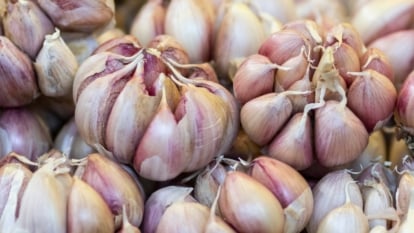
|
Plant Type Perennial Bulb Family Amaryllidaceae Genus Allium Species sativum var. sativum |
Native Area Central Asia to northeast Iran Exposure Full sun Height 1-1.5’ Watering Requireme Regular Watering |
Pests & Diseases Bulb rot, mites, and nematodes Maintenance Average Soil Type Well-drained Hardines 4-9 |
What Is It?
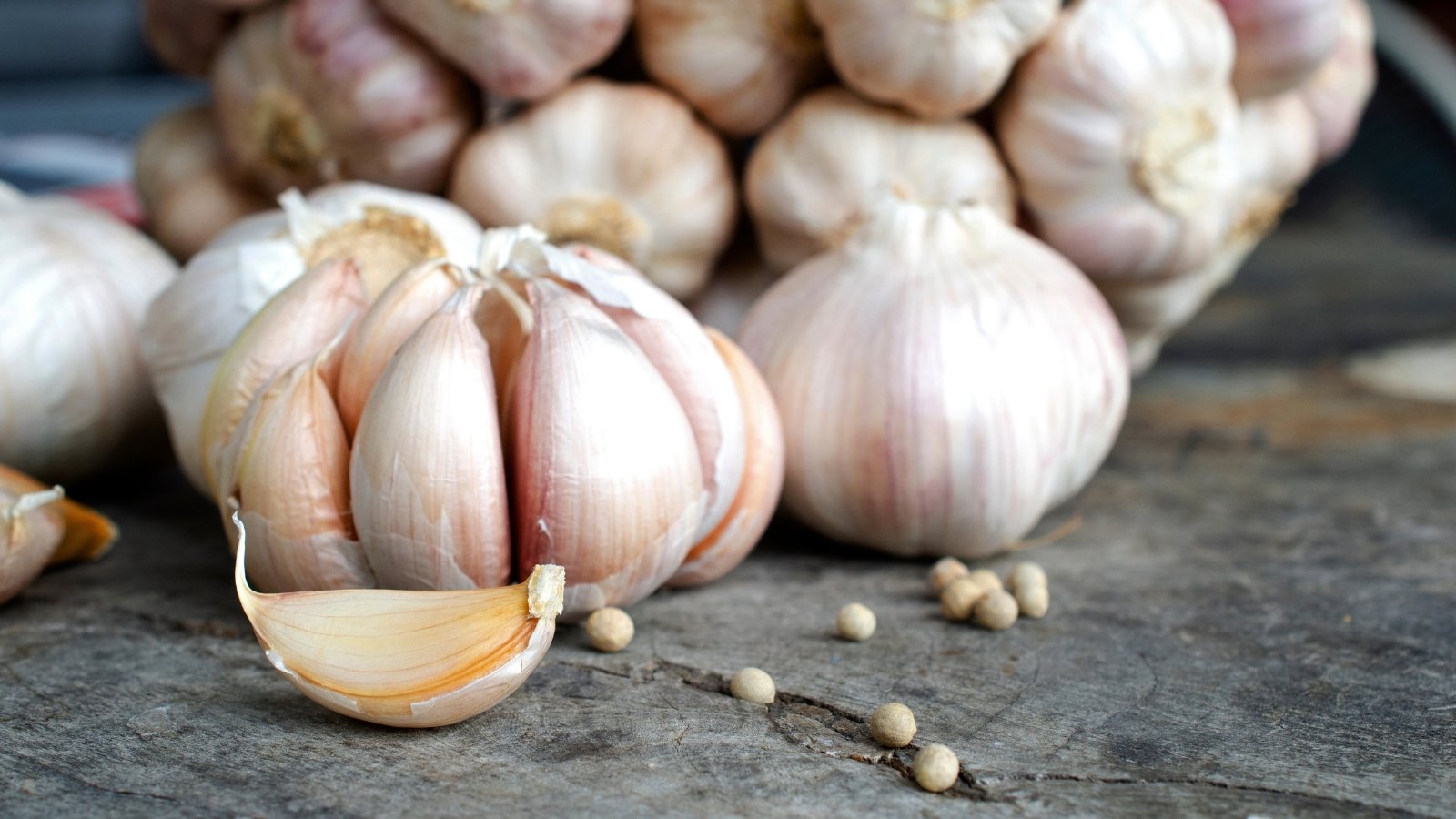 Freshly grown bulbs have flavor grocery stores can’t match.
Freshly grown bulbs have flavor grocery stores can’t match.Domesticated garlic is a perennial bulb in the amaryllis family. It’s a close relative of onions and leeks, and it is an essential cooking ingredient across the globe. Grow it yourself to enjoy the unmatched flavor that’s hard to find in the types at the grocery store.
Native Area
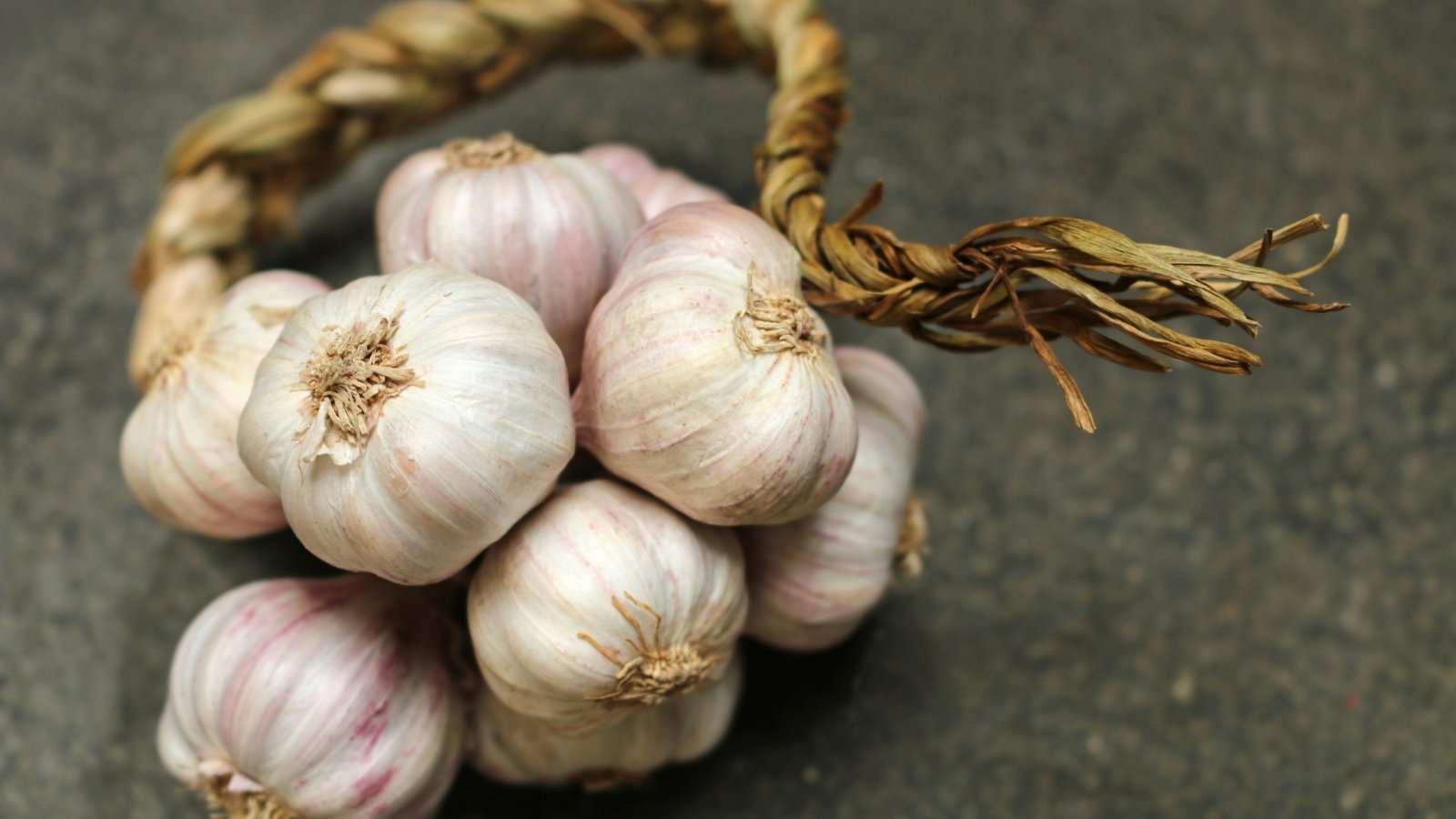 Hardy bulbs handle warmth, wet, and frosty zones.
Hardy bulbs handle warmth, wet, and frosty zones.Domesticated garlic, Allium sativum, originates from central Asia through northeast Iran. It is native to Iran, Kazakhstan, Kyrgyzstan, Tajikistan, Turkmenistan, and Uzbekistan. Garlic has since spread throughout the world, and it grows in gardens and farms on all major continents except for Antarctica.
‘Nootka Rose’ garlic originates from the San Juan Islands that sit near the Washington coastline. It’s a favorite variety because of its adaptability and supreme flavor. Grow it in the warm climate of Southern California, the wet of the Pacific Northwest, or the cold of the Northeast.
Characteristics
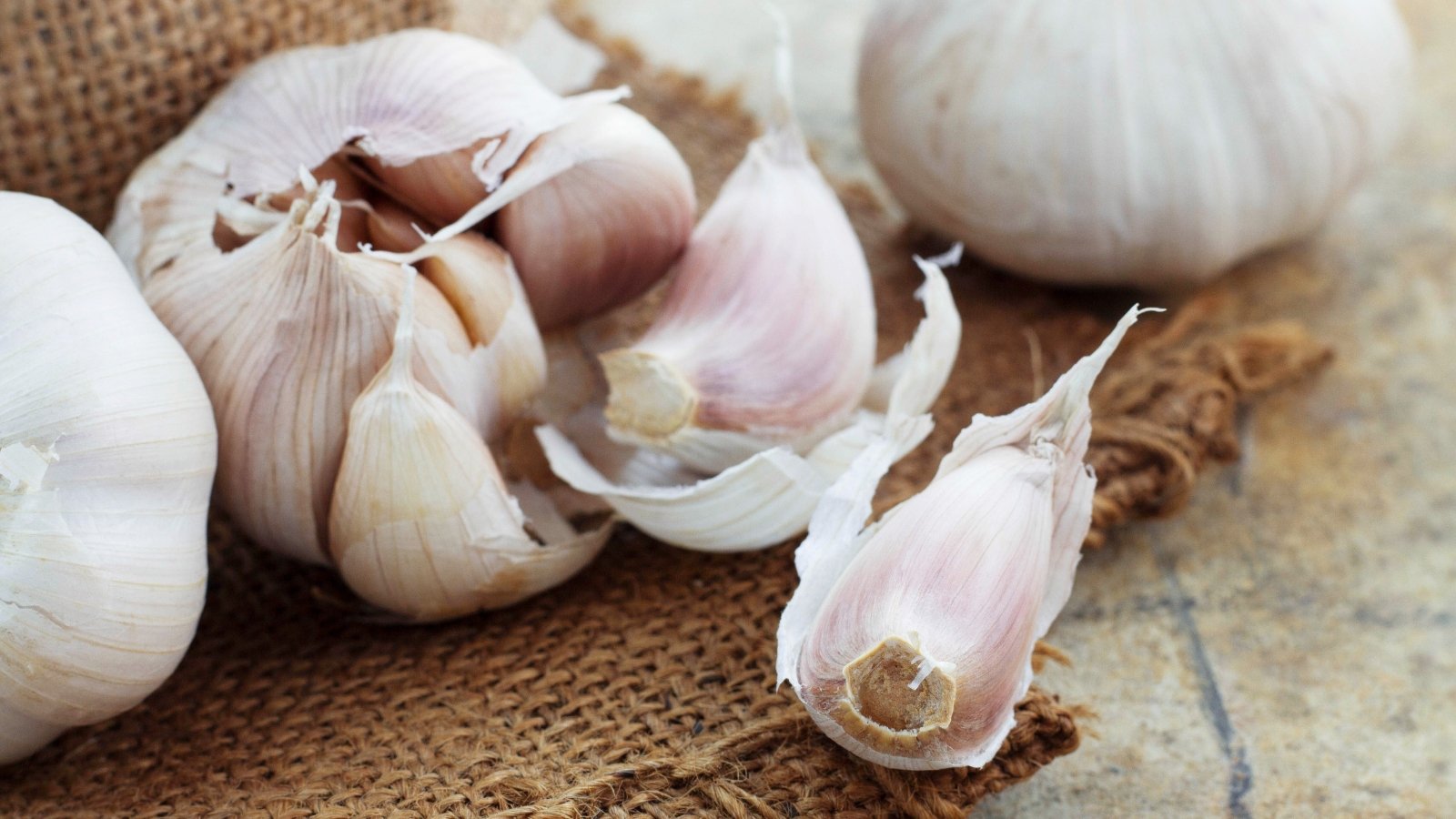 Multiple clove sizes fill each bulb perfectly.
Multiple clove sizes fill each bulb perfectly.‘Nootka Rose’ garlic features white, papery skin that covers the entire bulb. Each bulb carries 12 to 20 cloves of different sizes in multiple rows. When the plants grow well and have a proper curing process, their bulbs last for up to a year in storage.
As this cultivar grows, it requires little care to thrive. It’s a softneck variety. This means it won’t produce the flowering stalks known as scapes, and it doesn’t need frigid temperatures in the winter to grow properly. If other garlic plantings failed in your yard, this one may prove to be the new winner.
During the growing season, ‘Nootka Rose’ garlic produces long green leaves that are edible and tender when young. Trim the small leaves and add them to salads or sandwiches to impart a mild garlic flavor.
Planting
When to plant ‘Nootka Rose’ garlic depends on where you live. Unlike other crops, this bulb needs many months to grow well. You’ll plant it in fall or winter for a mid-summer harvest.
When to Plant
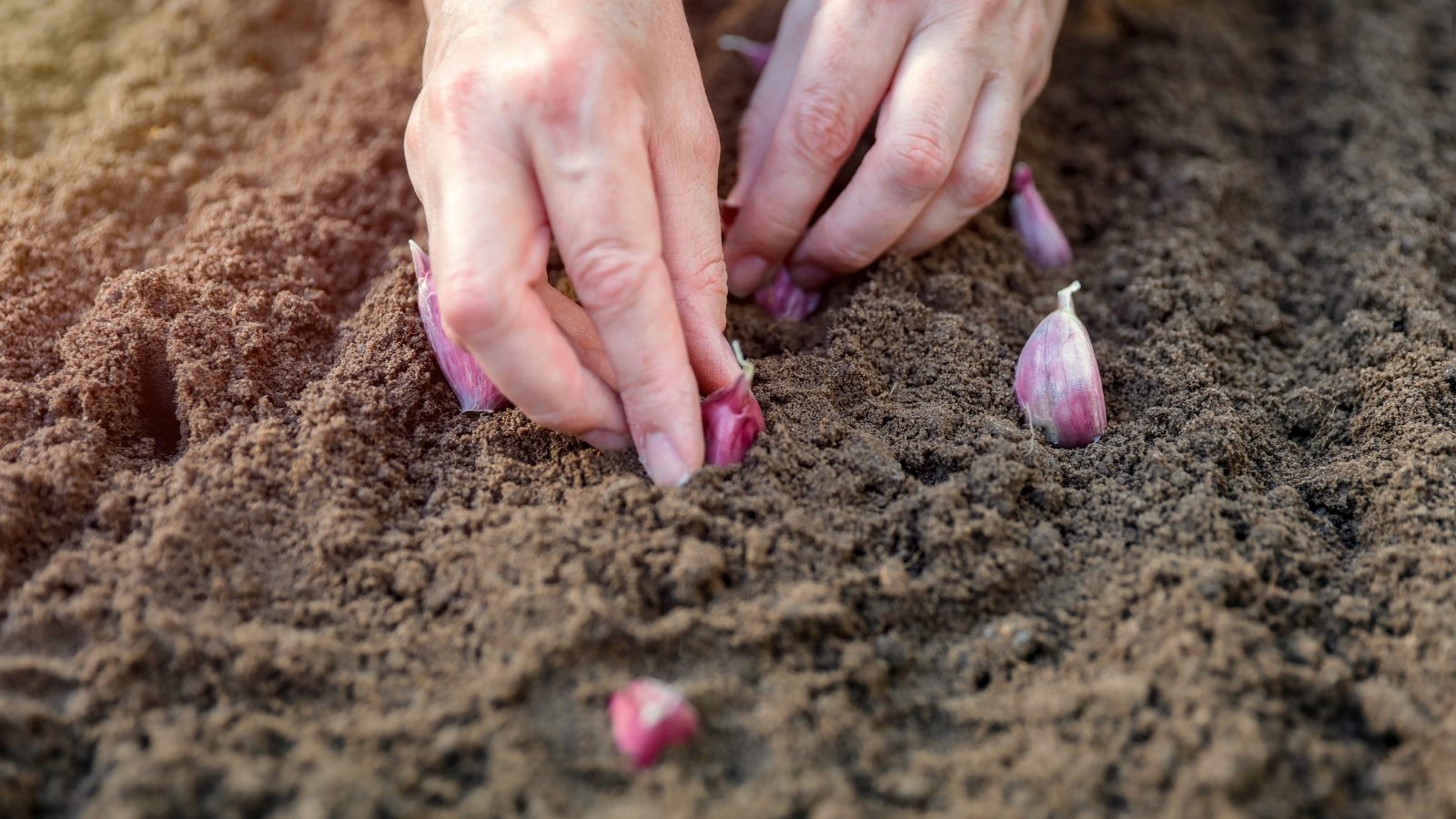 Plant cloves early for flavorful bulbs by summer.
Plant cloves early for flavorful bulbs by summer.Look at the USDA hardiness zone you live in, and determine when your first average frost date is. It’s best to plant this variety four to six weeks before the first hard freeze in your region. This will fall between September and November for most growers.
Gardeners with frost-free or mild winter climates may plant cloves up until January. Note that the bulbs need from seven to nine months to mature. Late plantings may not be ready until September, while early ones will likely finish from June through July.
Unlike most garlic, ‘Nootka Rose’ garlic requires no cold period. You don’t need to refrigerate the bulbs before planting; simply plant them in fall or winter, seven to nine months before you intend to harvest them.
How to Plant
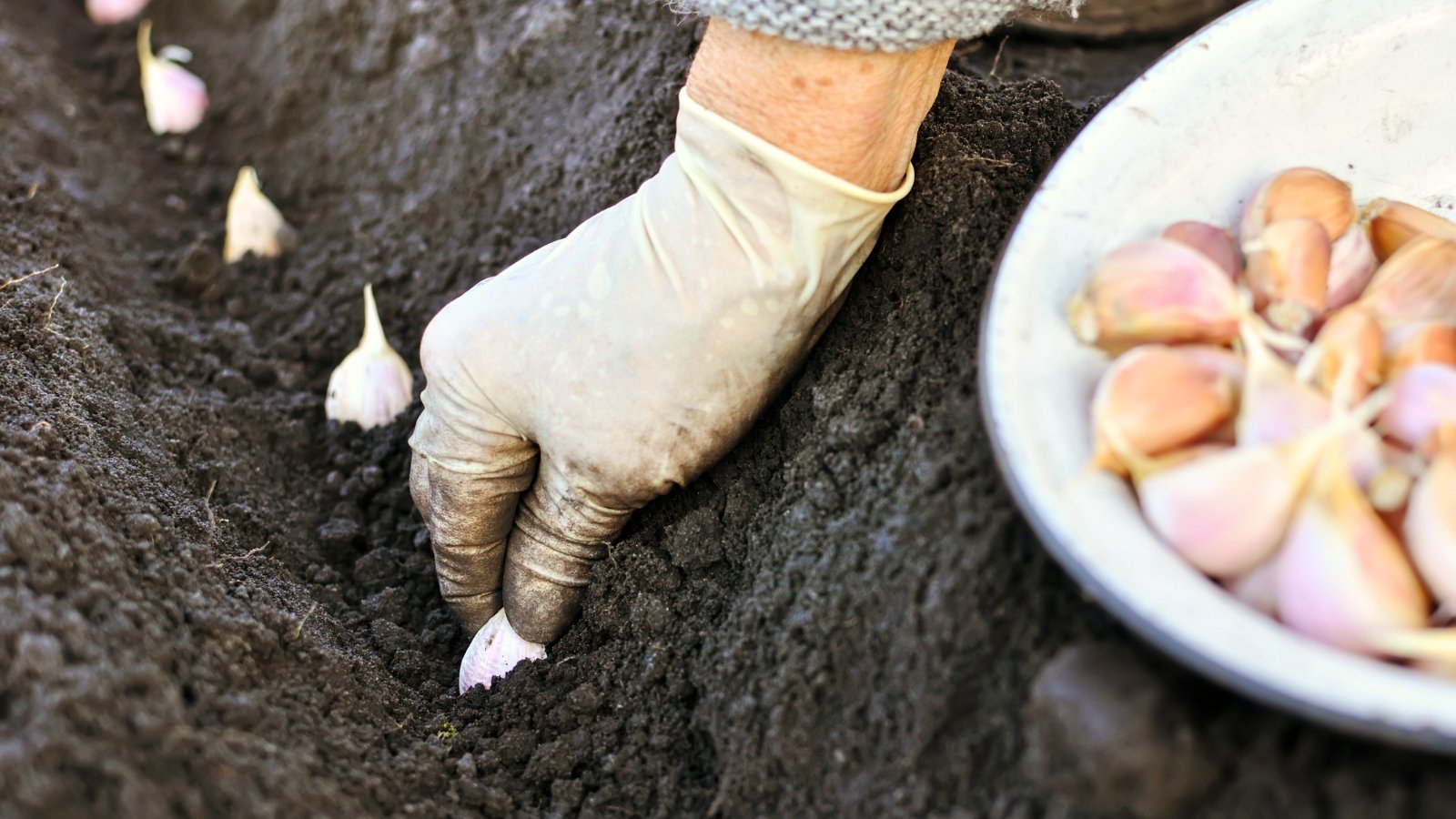 Space cloves well to grow plump, flavorful bulbs.
Space cloves well to grow plump, flavorful bulbs.Plant garlic in rows spaced a foot apart from each other. Bury the cloves pointed-tip side up two to three inches deep into the soil. Space each clove six inches apart to give the bulbs room to form.
After planting, cover the soil with a thick layer of mulch. Use compost, leaf mold, straw, or whatever you can find in your garden. Chopped leaves work well, and they’re readily available during the autumn season.
If you’re using containers, ensure they’re at least eight inches deep to allow room for the bulbs. Cover the soil in the pot with mulch, and place the containers in a protected area for the winter.
How to Grow
This hardy vegetable needs little to thrive. Give it good soil, regular irrigation, and plenty of sunlight. Though it’s perennial in hardiness zones 4 through 9, it’s possible to grow ‘Nootka Rose’ garlic as an annual in most parts of the U.S.
Light
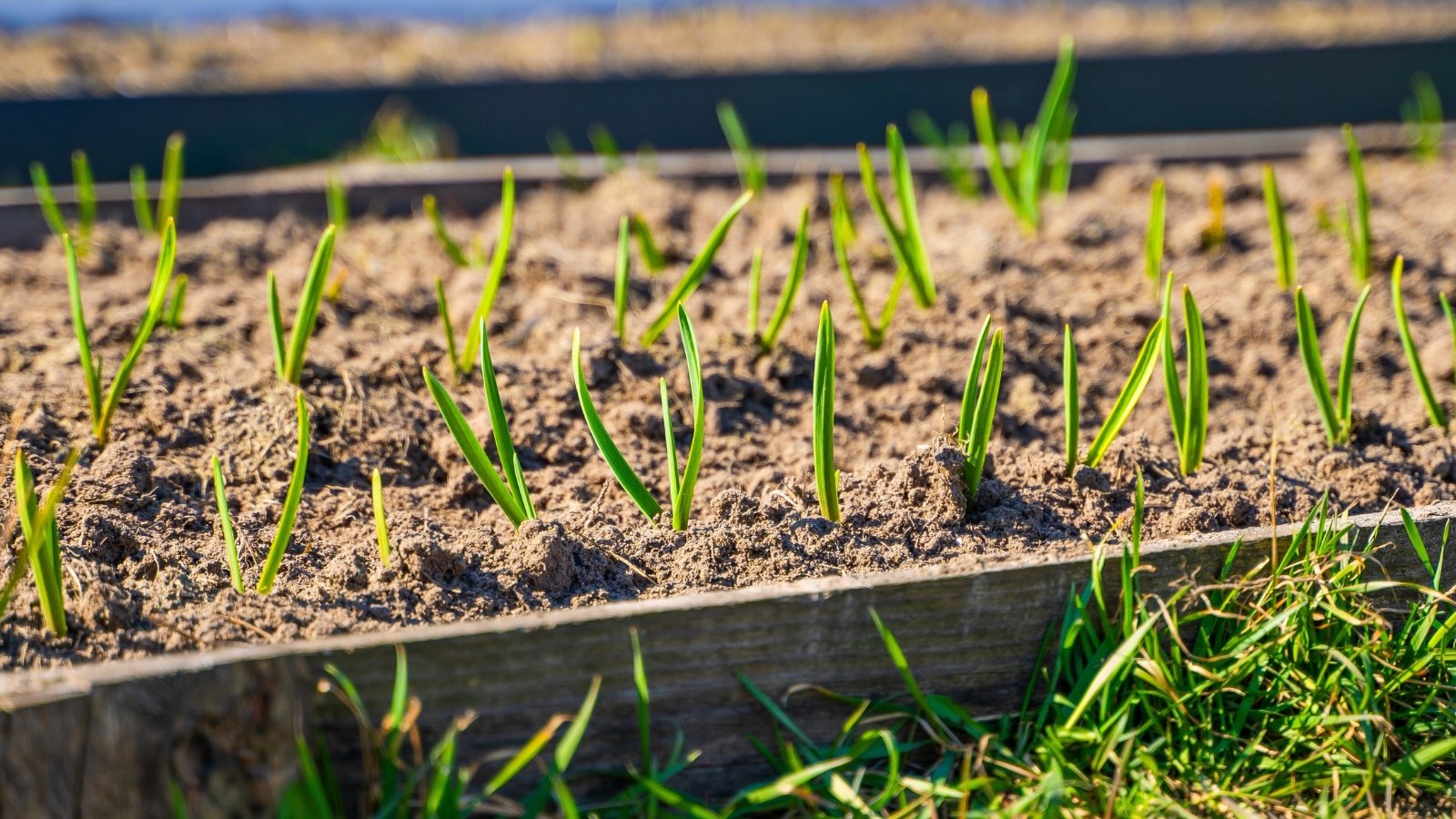 Sunny spots produce stronger plants with robust cloves.
Sunny spots produce stronger plants with robust cloves.This variety needs full sun to thrive. Partial shade is acceptable, though you may have fewer and smaller cloves to harvest than if you’d grown the crop in full sun.
Give your garlic six or more hours of daily direct sunlight during the growing season. Sunlight is less important during the dormant season, as the bulbs are leafless and don’t yet need light to photosynthesize.
The sun changes throughout the seasons, and a spot that’s sunny during planting may be shady in the spring. Take notes of your garden throughout the year so you can pick the perfect spot to plant the cloves in the fall.
Water
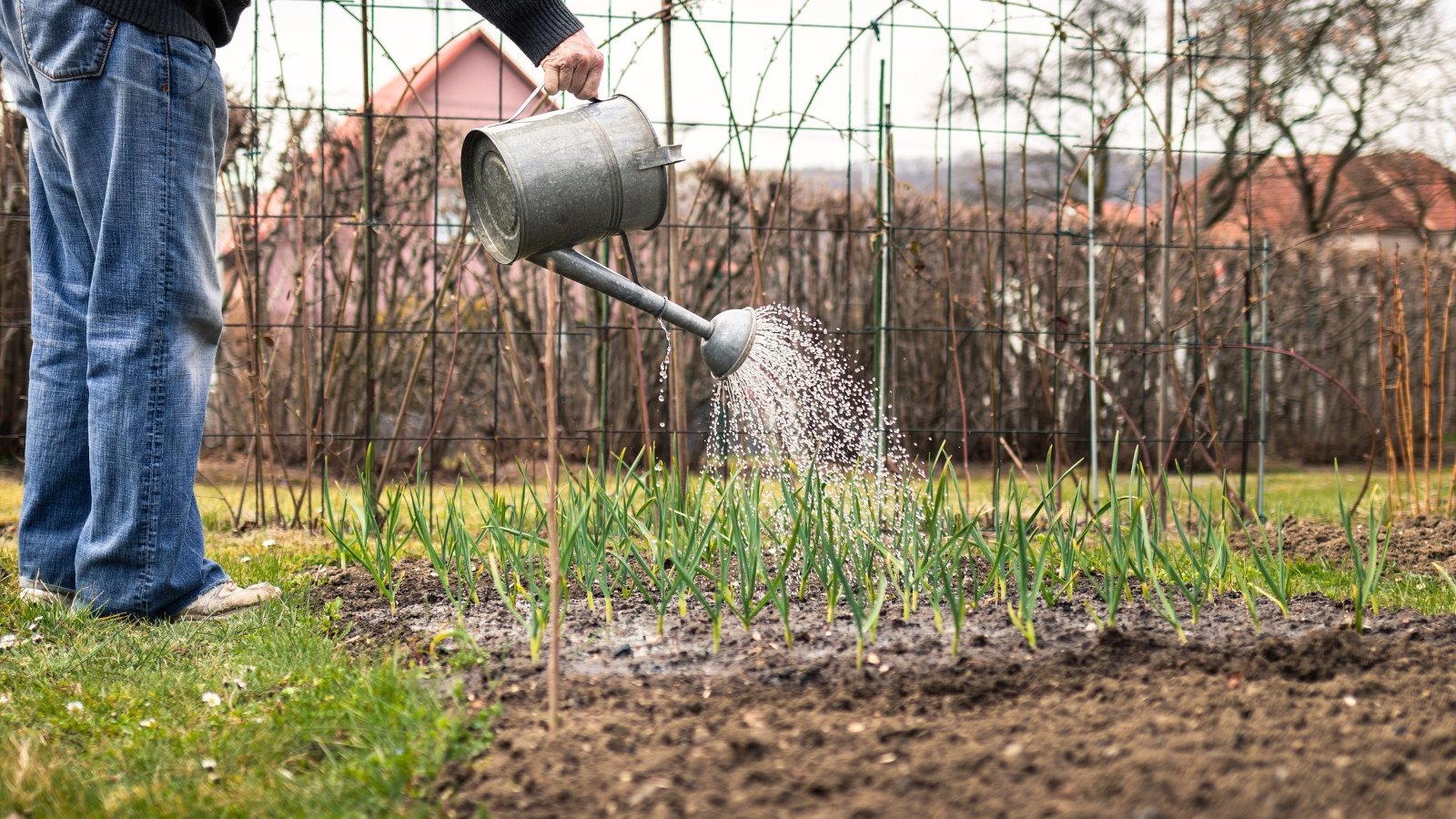 Keep soil moist but avoid letting it stay soggy.
Keep soil moist but avoid letting it stay soggy.This bulbous vegetable thrives in moist conditions. It dislikes soggy soil, though it’ll tolerate excess moisture from natural rainfall during the cold seasons. Let the soil dry between waterings to keep the plants rot-free.
You’ll likely have to water ‘Nootka Rose’ garlic once or twice weekly during the hot months, and less so during the cold season. Check the soil first before watering; let the surface dry, then add water to soak the ground.
If the soil feels moist on top and underneath the surface, wait to irrigate. Let the area dry for a while, then check it again to see if it’s ready for more irrigation.
Soil
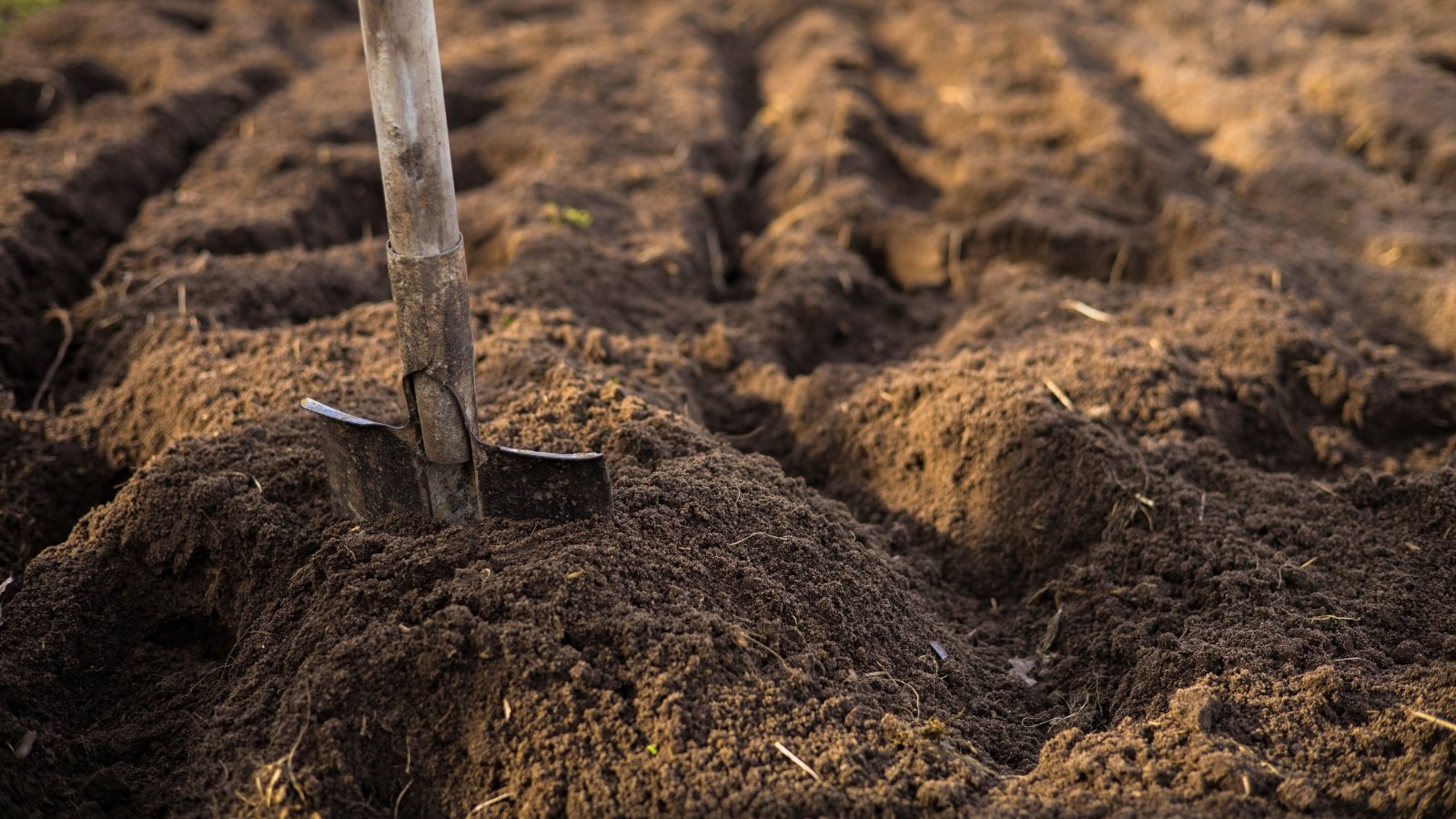 Loamy soil with compost nourishes cloves all season.
Loamy soil with compost nourishes cloves all season.The best soil for garlic is one that’s well-drained, loamy, and fertile. Avoid planting in extremely sandy or clay-rich areas where the bulbs may not perform well. Though this softneck variety is adaptable, it’s better to give it what it needs to perform than let it suffer.
Fill containers with a free-draining soil that has perlite, vermiculite, or pumice in it for long-term drainage. Most bagged potting soil mixes for vegetables work well, as will homemade composts or soil blends.
On top of the soil, add compost to feed and insulate the cloves below ground. As the seasons change, the compost will decompose into nutrients that garlic needs to grow well. The more you compost, the less you’ll need to fertilize.
Fertilizing
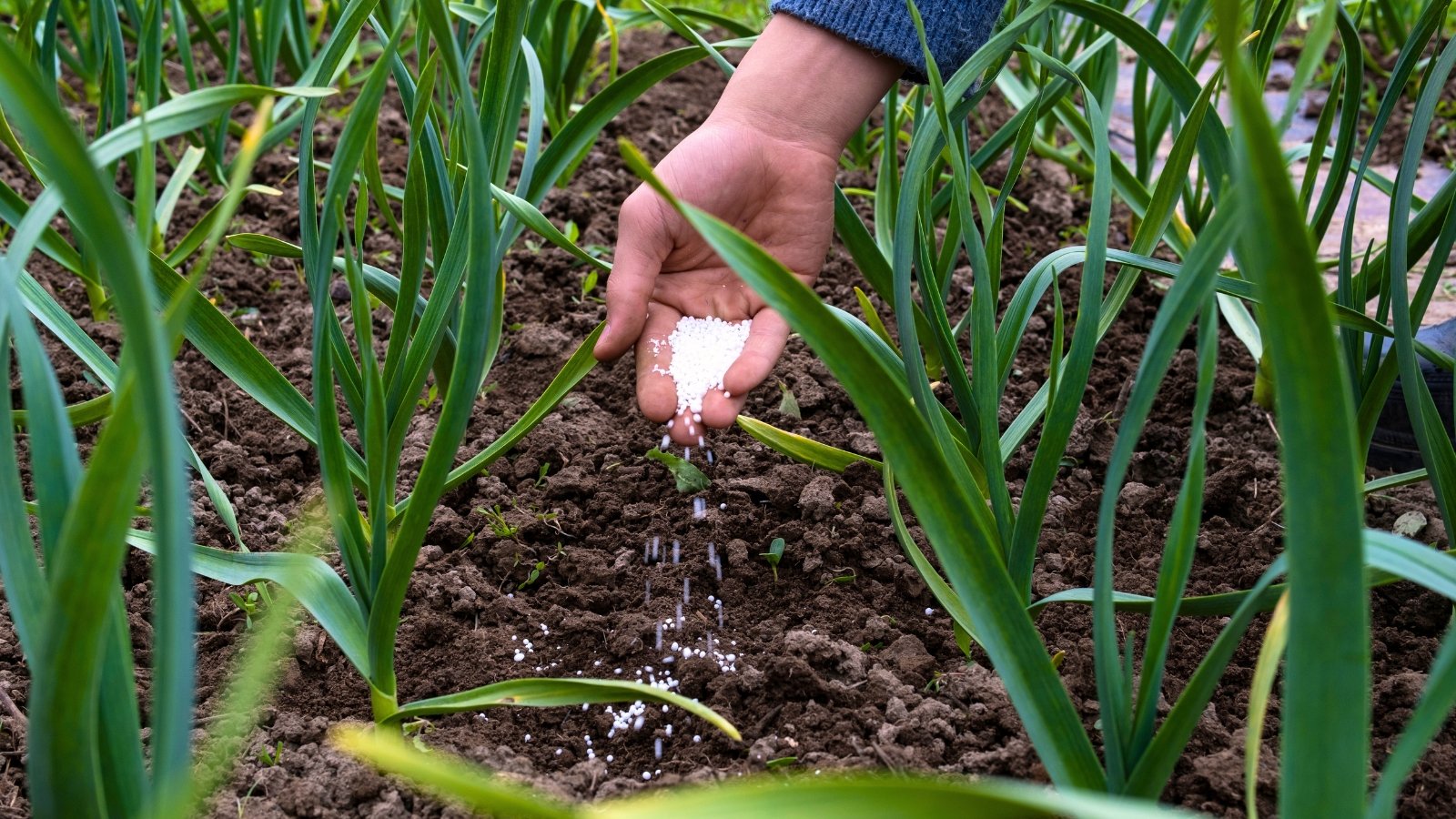 Spring feeding helps leafy growth develop strong stems.
Spring feeding helps leafy growth develop strong stems.Fertilizer is unnecessary if you’re regularly amending the site with compost. If you suspect the soil is missing nutrients, use a well-balanced organic fertilizer. Apply a normal dose in the spring when leafy growth is sprouting. Water the fertilizer in well, and wash it off the leaves if any of it got on them.
Potted plants need fertilizer if they’re growing in old soil or a soilless mix that’s low in nutrients. You may amend the pots with compost on top of the soil, or fertilize them with a normal dose in the spring.
Maintenance
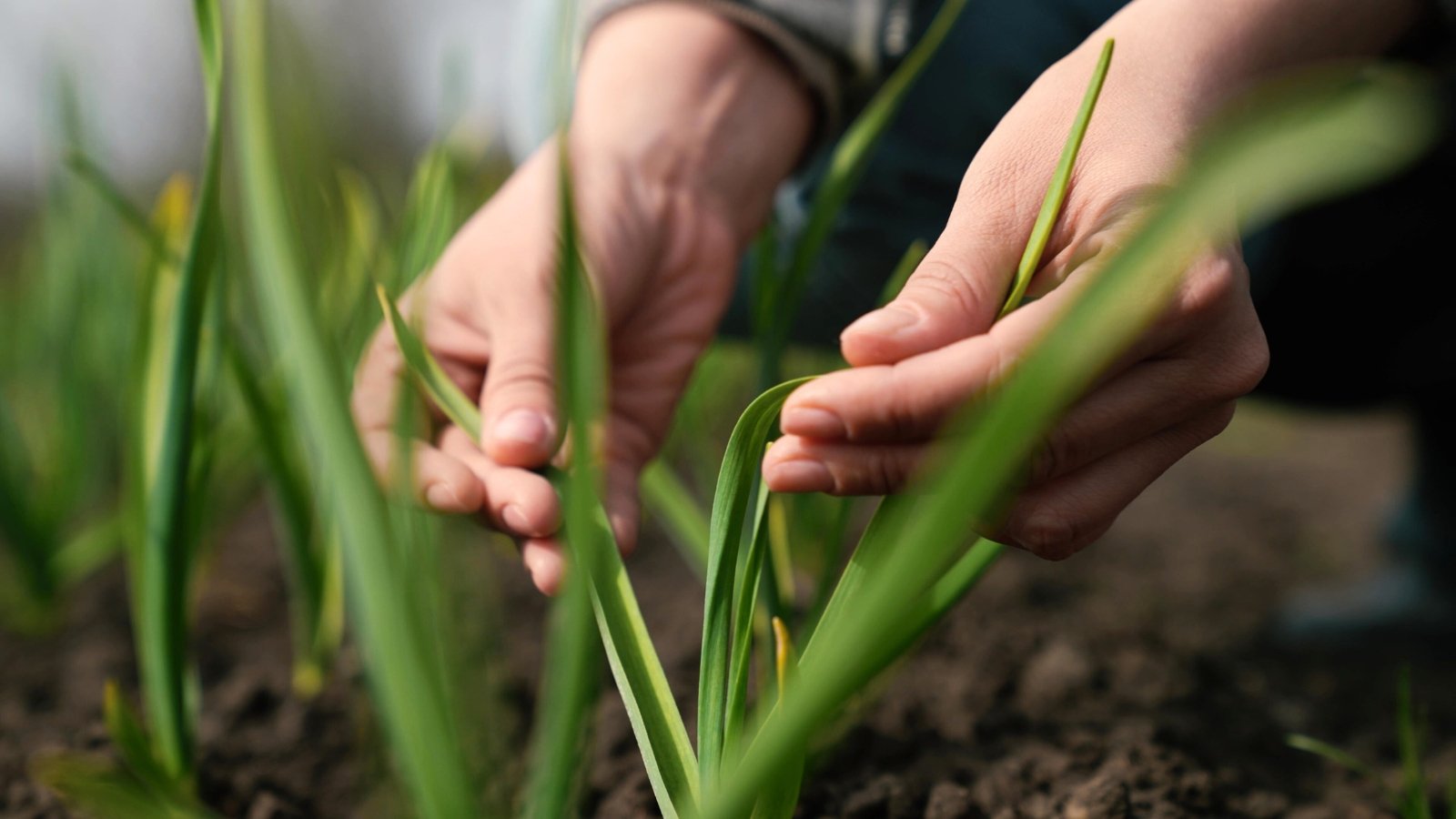 Inspect leaves often for pests or signs of disease.
Inspect leaves often for pests or signs of disease.Little maintenance is necessary during the growing season, though planting and harvesting are labor-intensive. You’ll need to get your hands dirty to both plant and harvest your crop.
Outside of regular watering, check your plants weekly or more often to ensure they’re thriving. Watch for pests and diseases on the leaves, and ensure the ground is weed-free while the bulbs grow.
Propagation
There’s one main way to propagate softneck garlic, and that’s with its cloves! This cultivar doesn’t produce scapes with bulbils, which are also called bulblets. It only grows bulbs underground that you may dig up and divide for further propagation.
Save Cloves
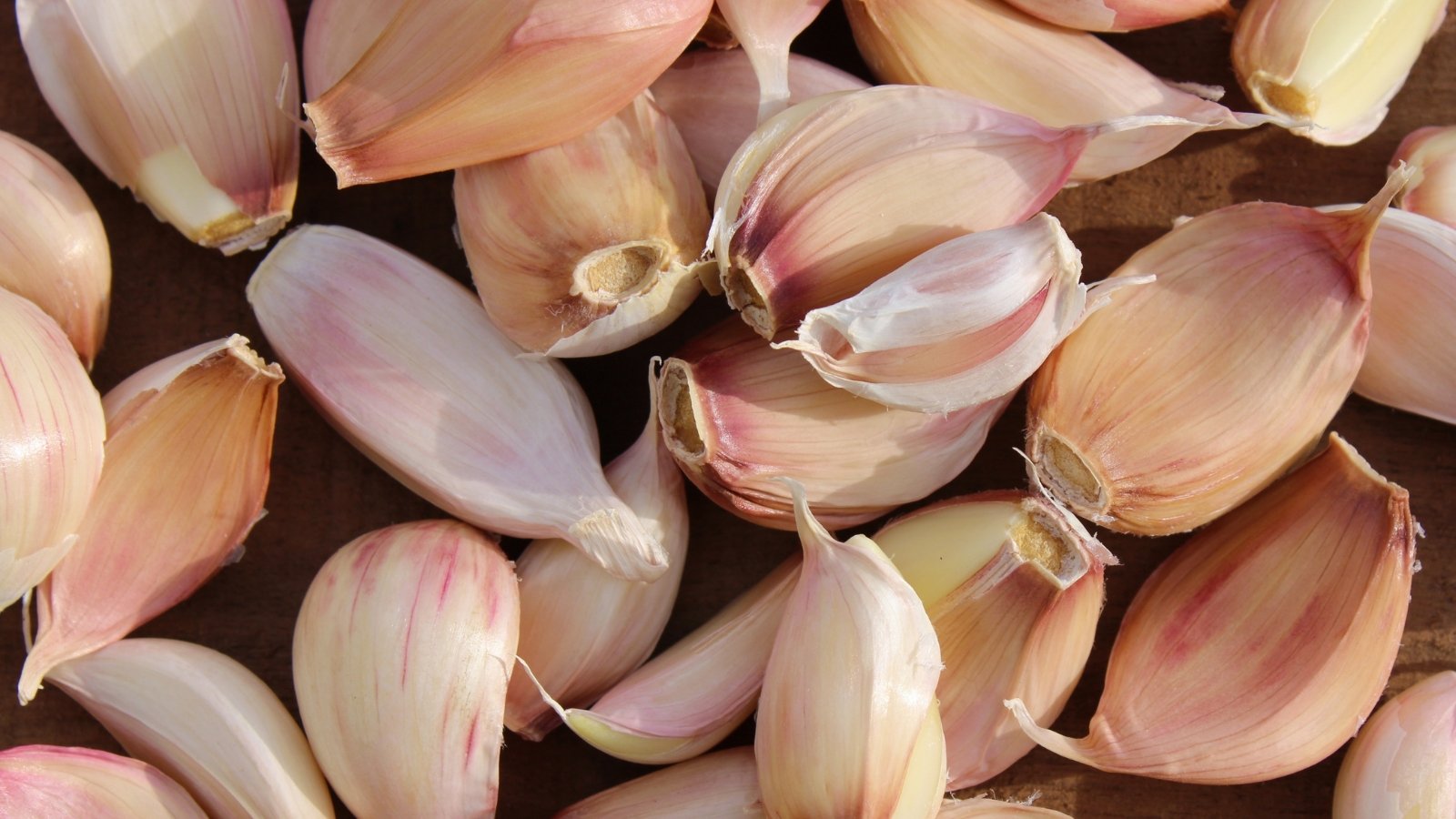 Keep harvested cloves cool and dry until planting.
Keep harvested cloves cool and dry until planting.It’s easy to save ‘Nootka Rose’ garlic cloves after harvesting your crop. The largest, healthiest cloves are the ones you want to save for planting. They’ll form the biggest bulbs next summer, as opposed to small, tiny cloves or bulbils.
Start by harvesting your bulbs. After they dry and cure, set a few aside for planting. Or, every time you use garlic in the kitchen, save the largest cloves of each bulb to plant later on.
Keep the garlic dry and cool until you’re ready to plant it. If you’re purchasing this variety, ensure you’re buying certified pest and disease-free bulbs from a reputable source.
Harvesting and Storage
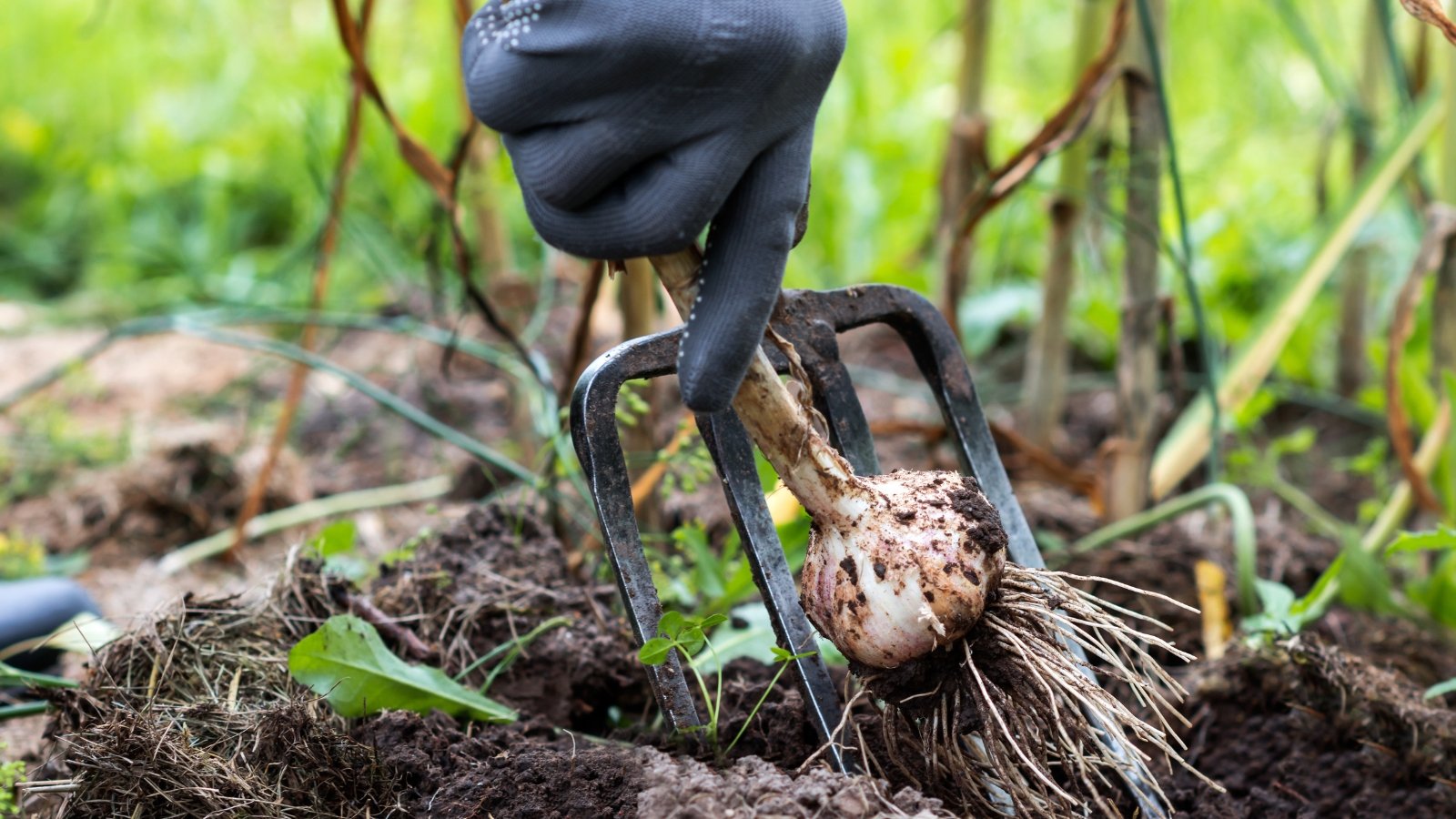 Lift bulbs carefully when lower leaves start yellowing.
Lift bulbs carefully when lower leaves start yellowing.Harvest the crops when their lower leaves begin turning yellow and brown. Don’t let the whole plant turn yellow, and instead harvest when the lower two or three leaves change color. To harvest, use a broadfork or pitchfork and carefully lift them from the ground.
Stab the fork underneath the bulbs, well below where they’d be growing. Lift, and watch as each bulb loosens from the dirt. Take the plants, leaves and all, and move them to a shaded, dry, and well-aerated location for curing.
Cure the harvest by hanging each stalk up to dry. Let the leaves turn brown and crunchy, then snip the papery bulbs from their tops a week or two after hanging them. Store the cured garlic in a cool, dry, and dark place for up to a year.
Common Problems
Compared to crops like tomatoes and corn, softneck garlic is relatively pest-free. It’ll occasionally succumb to rot in poor growing conditions, and nematodes or mites where they’re common. Avoid issues by keeping the plants well-fed and watered, and by practicing crop rotation.
Pests
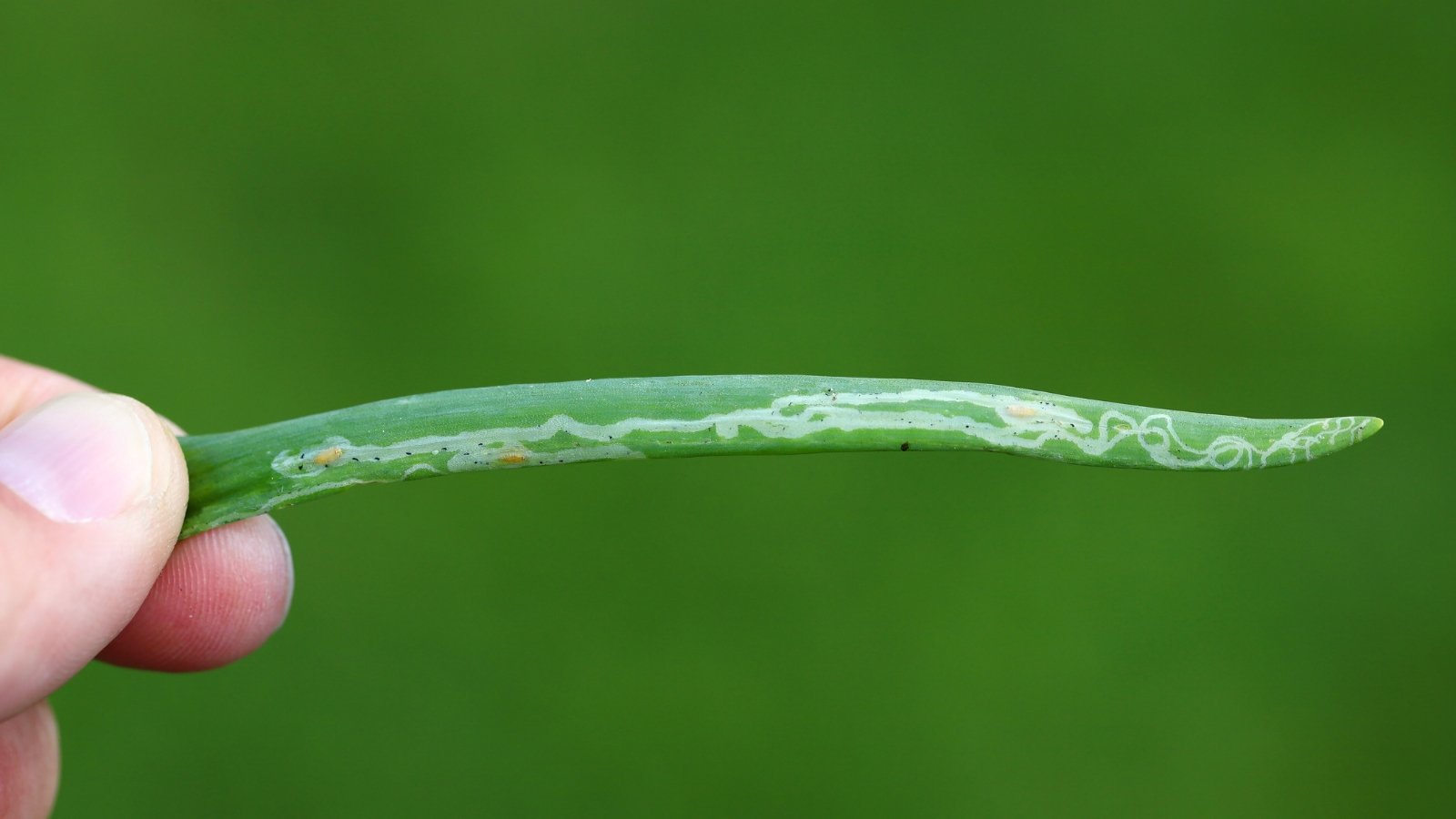 Leafminers nibble leaves but rarely harm the cloves.
Leafminers nibble leaves but rarely harm the cloves.Leafminers and thrips may target the leaves, though they’re harmless to the cloves. They cause more cosmetic damage than anything else.
Nematodes live in the soil, and they infest healthy cloves. Their entrances and tunnels make way for fungi and bacteria to infest the plants, causing rot-like symptoms. Keep them away by rotating your crops if you detect them. Avoid planting alliums in the spot for three or more years.
Mites target the space between the cloves and the roots. They, like nematodes, allow for diseases to enter the bulbs. Discard mite-infested cloves and plant pest-free ones in a different area with fresh compost.
Diseases
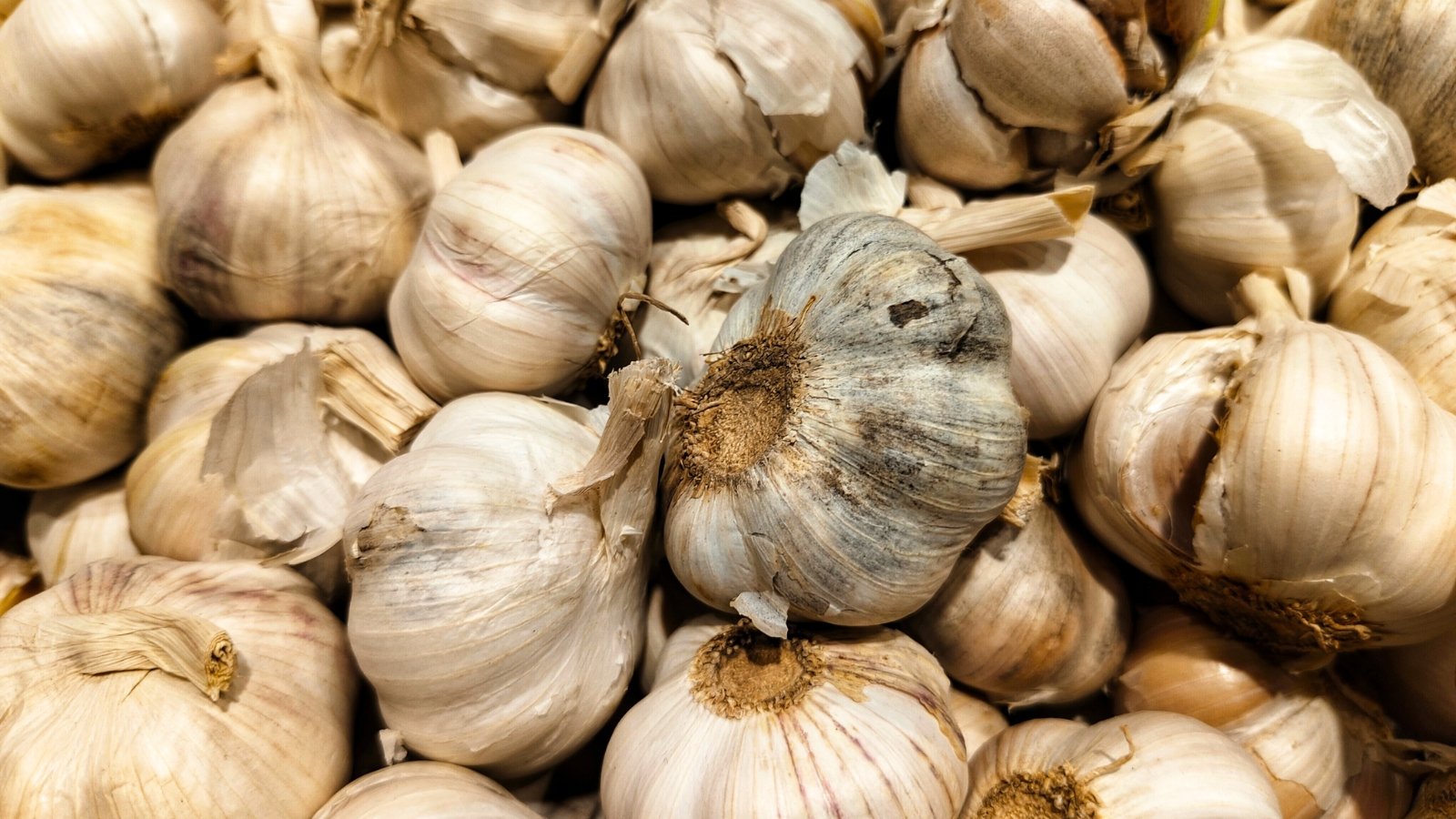 Inspect harvested bulbs and discard any showing rot.
Inspect harvested bulbs and discard any showing rot.Watch for bulb rot, which stems from a variety of fungi and bacteria that target garlic and its onion relatives. Prevent it by practicing crop rotation, using mulch, and growing garlic in well-drained soil.
If rot occurs, discard the infected plants and move them far away from your other ones. The same goes for cured garlic—if you detect rot, throw the bulb out and inspect the others for symptoms.
Frequently Asked Questions
Grow garlic with tomatoes, peppers, and eggplants. They have similar growing conditions, and they help each other repel pests.
Cover the planting site with a thick layer of mulch to protect it from frost during the winter.
It’s likely due to root rot. Lift a wilting plant to check its roots, then diagnose the growing issue.


 2 days ago
4
2 days ago
4
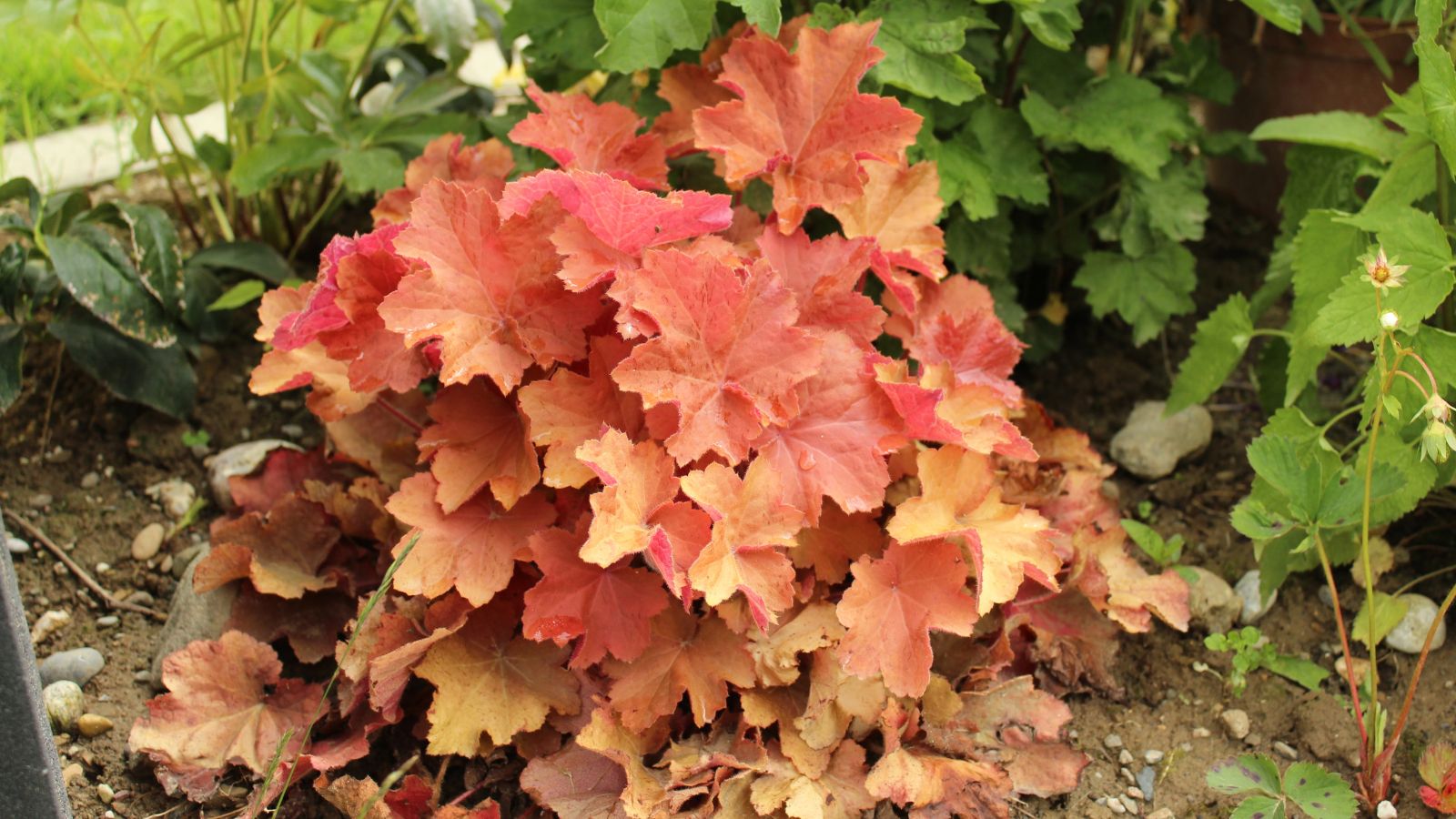
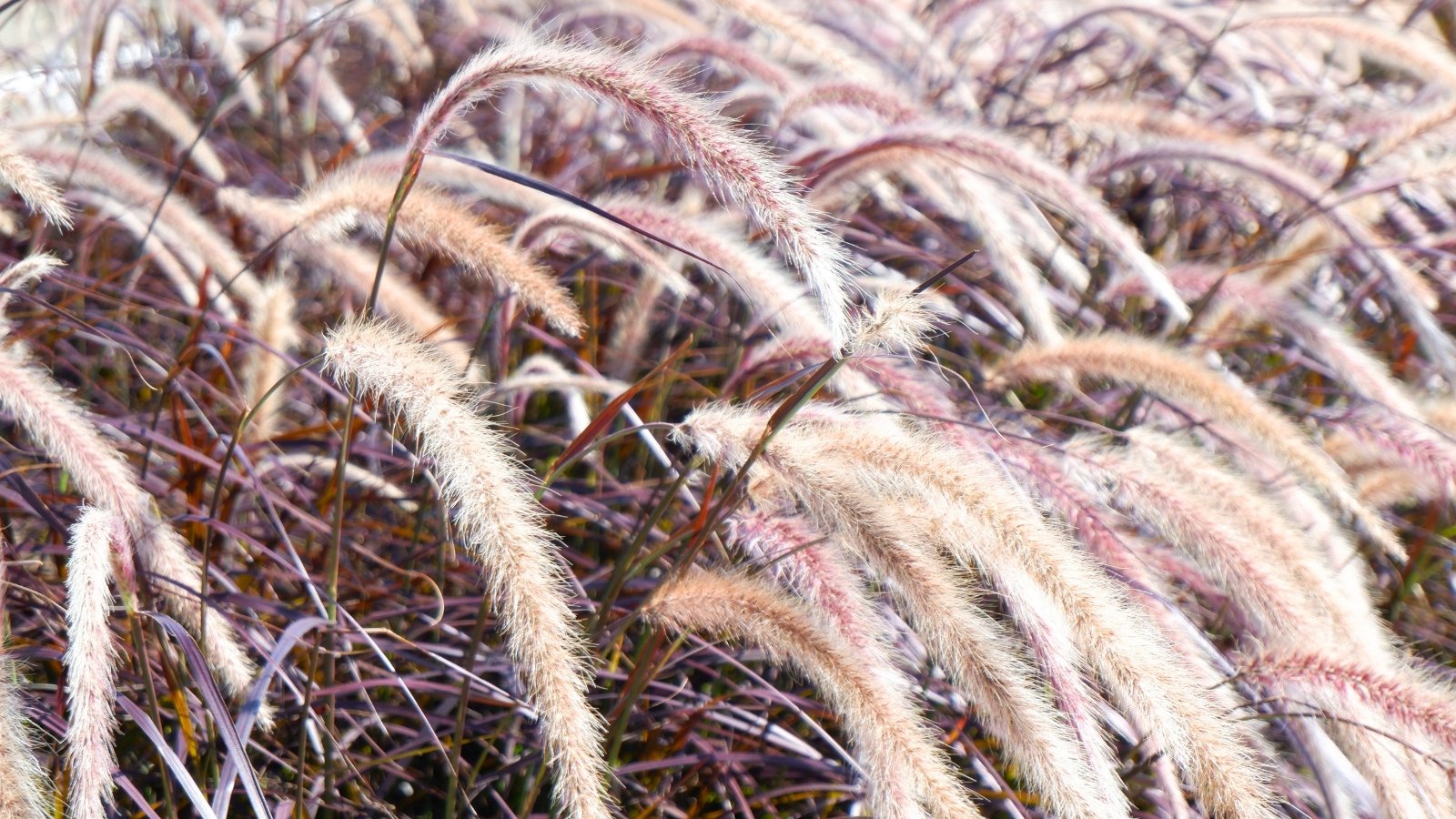

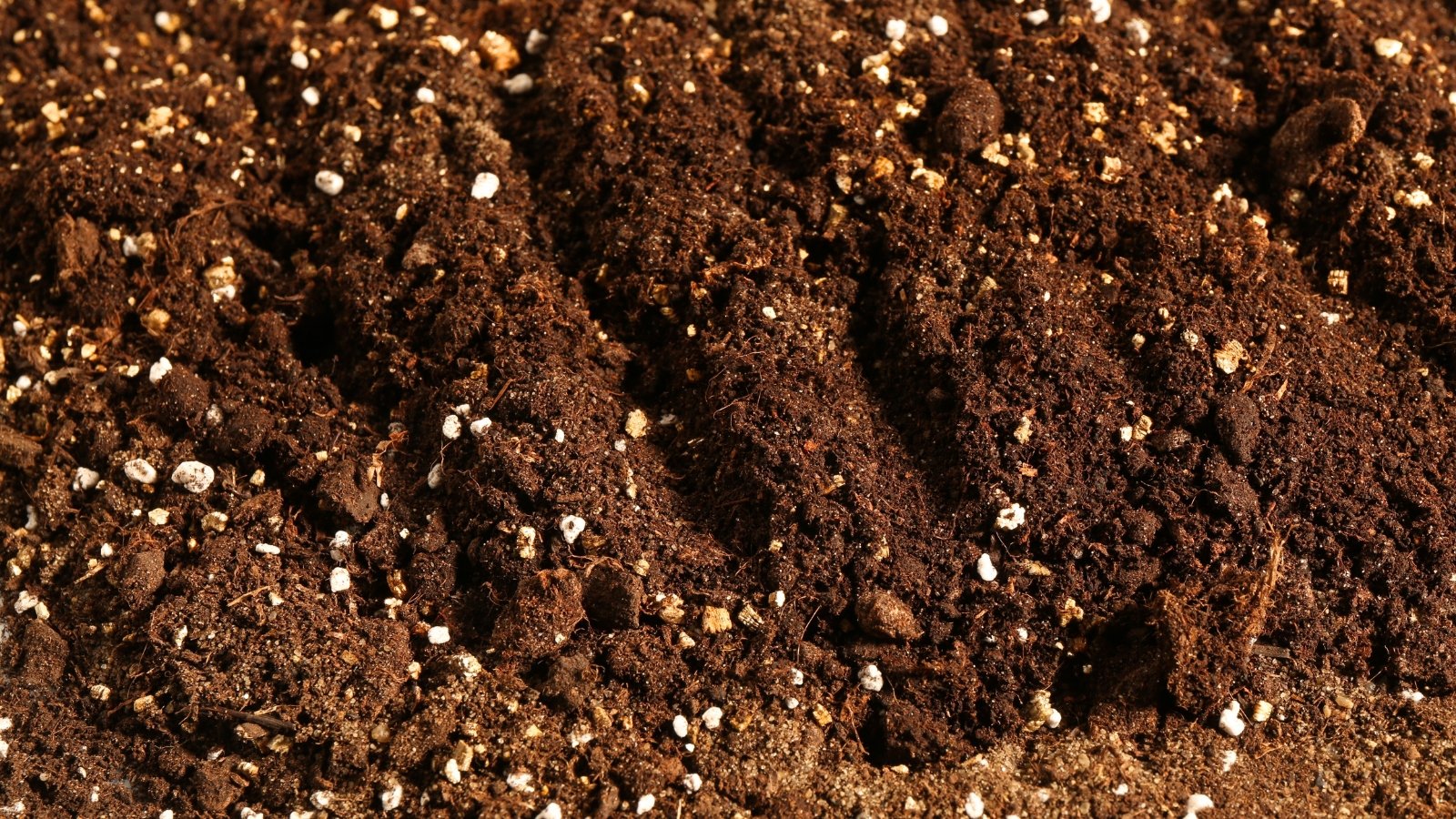
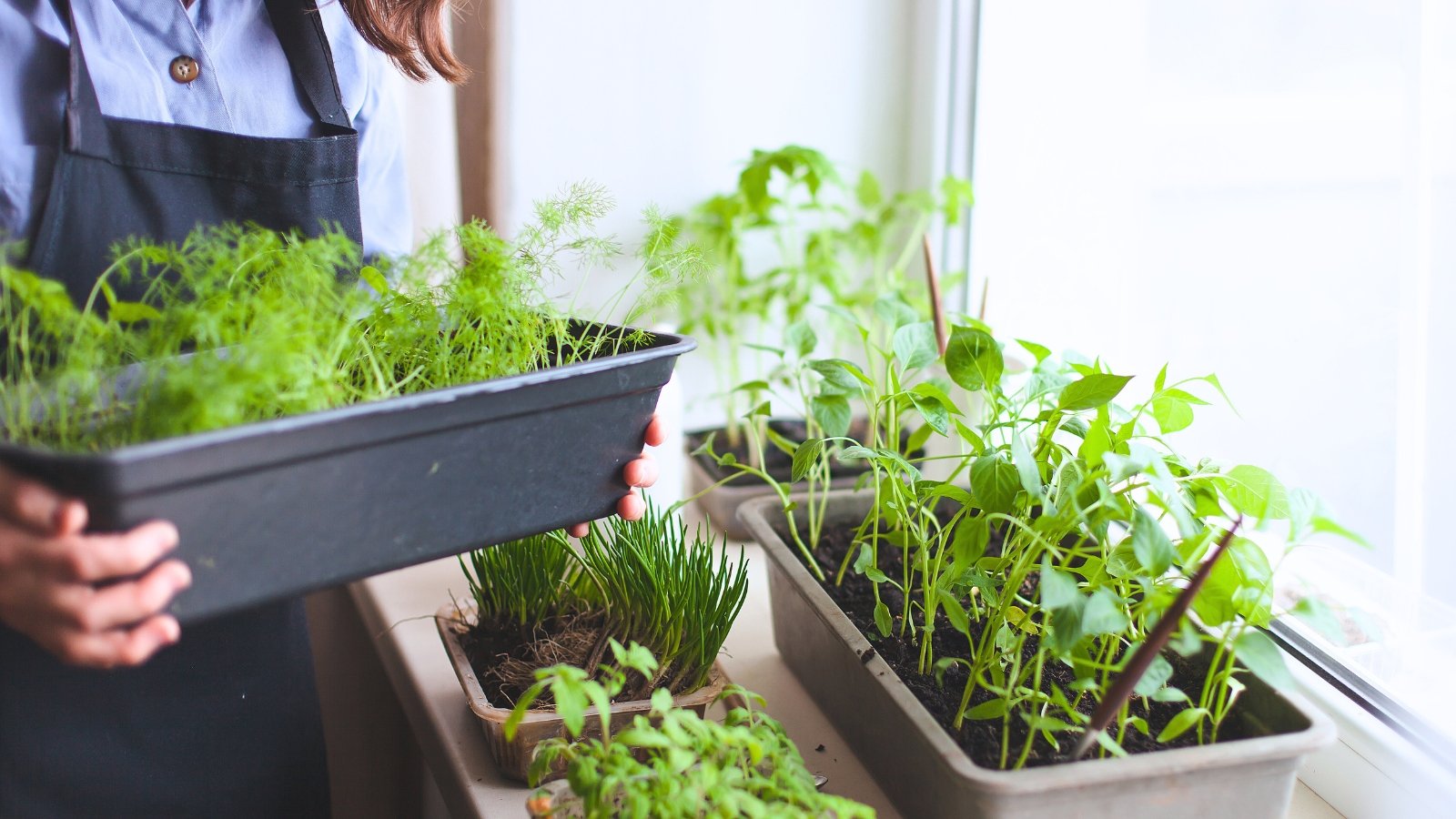
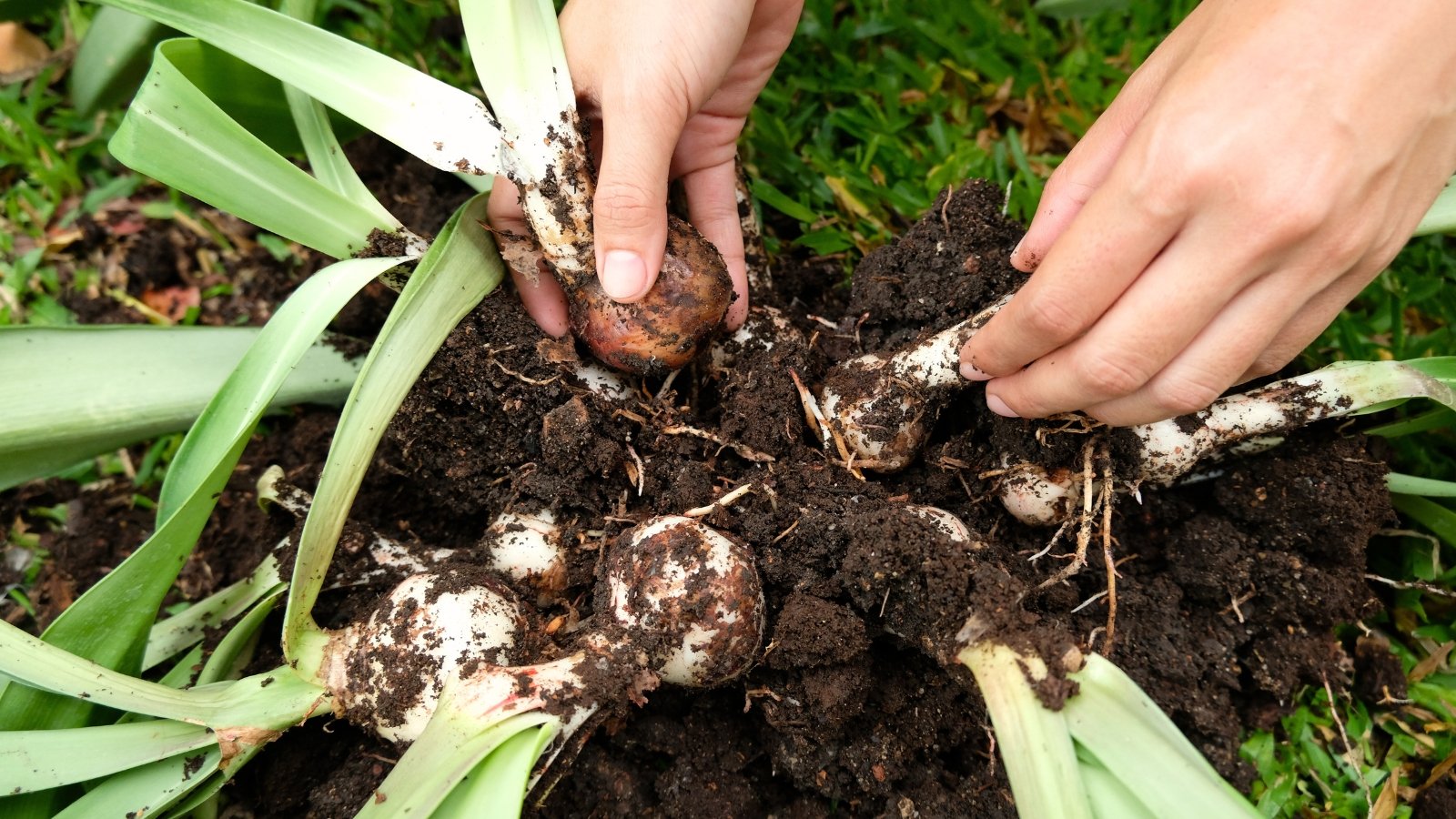















 English (US) ·
English (US) ·  French (CA) ·
French (CA) ·